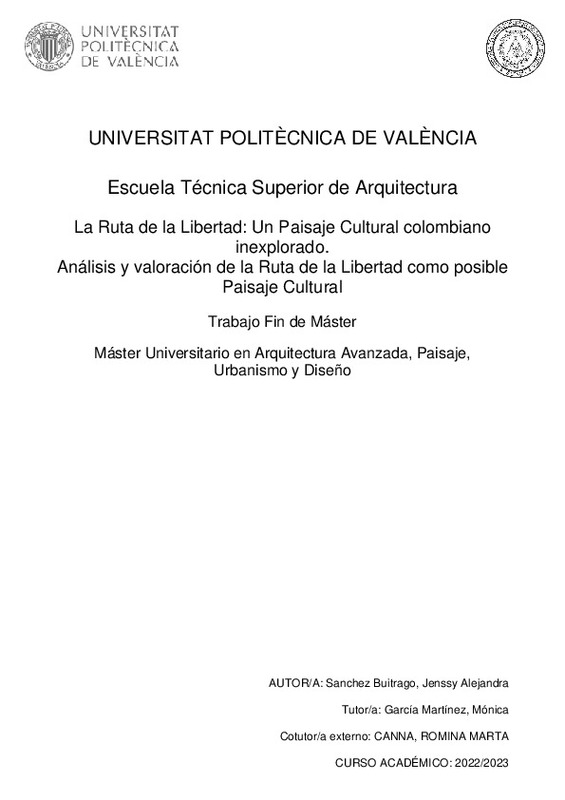|
Resumen:
|
[ES] Consecuente con la importancia de vincular a la cultura en los procesos contemporáneos
de valorización patrimonial y desarrollo territorial, durante las últimas décadas, la
UNESCO se ha esforzado por identificar ...[+]
[ES] Consecuente con la importancia de vincular a la cultura en los procesos contemporáneos
de valorización patrimonial y desarrollo territorial, durante las últimas décadas, la
UNESCO se ha esforzado por identificar aquellos bienes que por su valor universal
excepcional constituyen el Patrimonio Mundial de la Humanidad. Aludiendo al territorio
y sus cualidades, dentro de la Lista representativa del Patrimonio Mundial se encuentran
referenciados los Paisajes Culturales, que son ¿lugares que combinan el trabajo de la
naturaleza y el ser humano, ilustrativos de la evolución de la sociedad humana y del uso
del espacio a lo largo del tiempo, bajo la influencia de limitaciones físicas y/u
oportunidades presentadas por el medio natural y de sucesivas fuerzas sociales,
económicas y culturales¿ (Comité de Patrimonio Mundial de la UNESCO, 1992)
Fruto del interés en la cultura y su promoción, año tras año en el mundo, numerosas
naciones identifican en su territorio nuevos Paisajes Culturales. Sin embargo, aunque la
cifra de Paisajes Culturales inscritos aumenta consecutivamente, resulta inquietante la
insuficiente representatividad que América Latina ha conseguido dentro de la globalidad
de bienes registrados. Dicho fenómeno conducirá en el presente trabajo a un riguroso
estudio y análisis del Paisaje Cultural en la región latinoamericana, y posteriormente, a la
proposición de La Ruta de La Libertad como un nuevo Paisaje Cultural a identificar.
Partiendo de los acuerdos y resoluciones que dirigen al proceso de inscripción de los
Paisajes Culturales como Patrimonio Mundial, arribados en el contexto colombiano, se
indagarán y expondrán cuáles son los organismos y procesos claves que participan en la
identificación, inscripción y manejo del Paisaje Cultural como parte del Patrimonio de la
Nación. Para tal efecto, se referenciará al Paisaje Cultural Cafetero Colombiano, el primer
Paisaje Cultural colombiano inscrito oficialmente dentro de la Lista Representativa del
Patrimonio Mundial de la Humanidad.
Finalmente, referenciando la experiencia y procesos producidos en torno a la inscripción
oficial del Paisaje Cultural Cafetero Colombiano como parte del Patrimonio Mundial, se
presentará un estudio ordenado y detallado de los elementos y bienes patrimoniales, de
orden cultural y natural, que conforman a la Ruta de la Libertad. Acompañando su
contextualización y descripción, se presentarán las dinámicas y relaciones que estos
elementos patrimoniales recrean en el territorio. A través de sus atributos reconocidos
en el territorio y patrimonio, se expondrá el valor universal excepcional y potencial que
esta Ruta Libertadora presenta, potencial que justifica y demuestra la necesidad de
abordar a este territorio como un nuevo Paisaje Cultural de la Nación y de la Región
[-]
[EN] Consequent to the importance of involving culture in contemporary processes of heritage
valorization and territorial development, during the last decades, UNESCO has made an
effort to identify those elements that, ...[+]
[EN] Consequent to the importance of involving culture in contemporary processes of heritage
valorization and territorial development, during the last decades, UNESCO has made an
effort to identify those elements that, due to their exceptional universal value, constitute
the World Heritage of Humanity. Referring to the territory and its qualities, the World
Heritage Representative List includes Cultural Landscapes, which are "places that
combine the work of nature and man, illustrative of the evolution of human society and
the use of space over time, under the influence of physical constraints and/or
opportunities presented by the natural environment and of successive social, economic
and cultural forces" (UNESCO World Heritage Committee, 1992).
Because of the interest in culture and its promotion, year by year, numerous nations
around the world identify new Cultural Landscapes in their territory. However, although
the number of inscribed Cultural Landscapes increases consecutively, it is of concern the
insufficient representation that Latin America has achieved within the list of registered
properties as a whole. This phenomenon will lead this paper to a rigorous study and
analysis of the Cultural Landscape in the Latin American region, and subsequently, to the
proposal of La Ruta de La Libertad as a new Cultural Landscape to be identified.
Starting from the agreements and resolutions that guide the process of inscription of
Cultural Landscapes as World Heritage, arrived in the Colombian context, it will be
investigated and exposed which are the key organisms and processes that participate in
the identification, inscription and management of the Cultural Landscape as part of the
Nation's Heritage. To this effect, the Colombian Coffee Growing Cultural Landscape, the
first Colombian Cultural Landscape to be officially inscribed on the Representative List of
World Heritage of Humanity, will be referenced.
Finally, based on the experience and processes produced around the official inscription
of the Colombian Coffee Growing Cultural Landscape as part of the World Heritage, a
detailed and orderly study of the cultural and natural heritage elements which constitute
La Ruta de la Libertad, will be provided. Accompanying its contextualization and
description, the dynamics and relationships that these heritage elements recreate in the
territory will be presented. Through its recognized attributes in the territory and heritage,
will be exposed the universal exceptional value and potential of this Route, a potential
that justifies and demonstrates the need to consider this territory as a new Cultural
Landscape of the Nation and of the Region.
[-]
|







